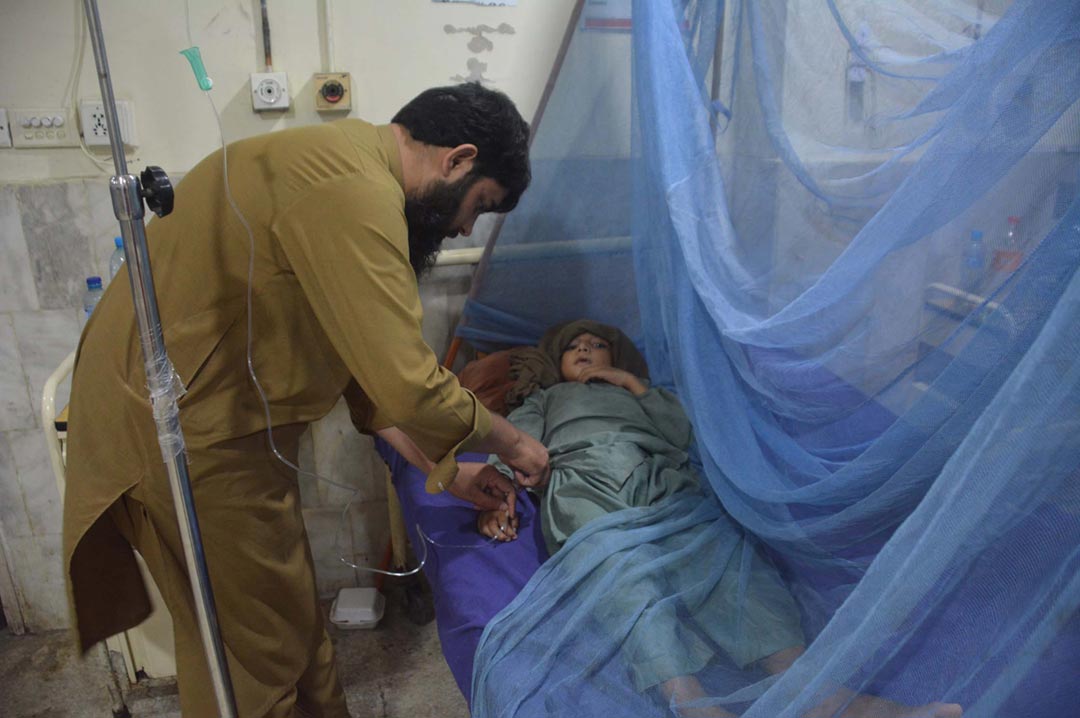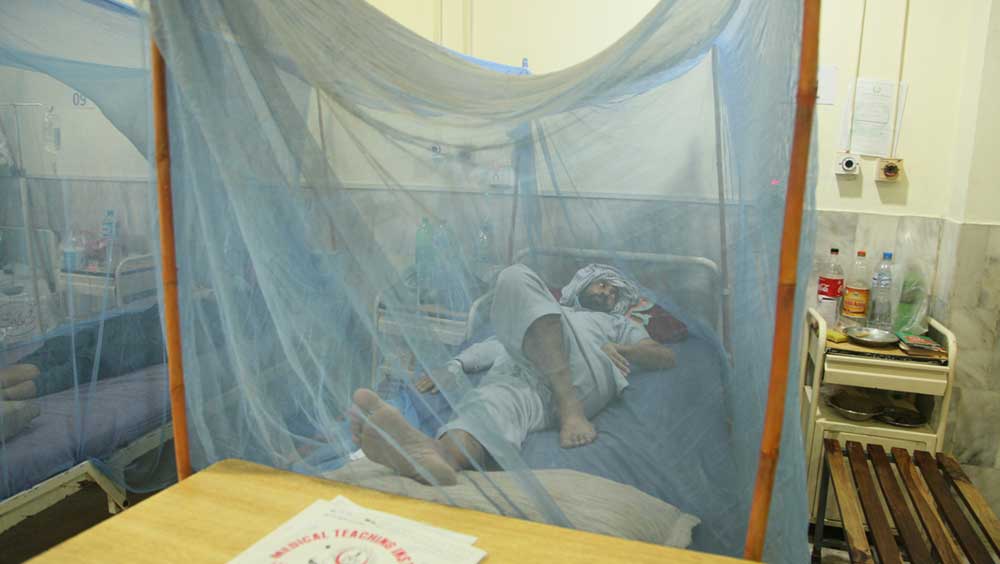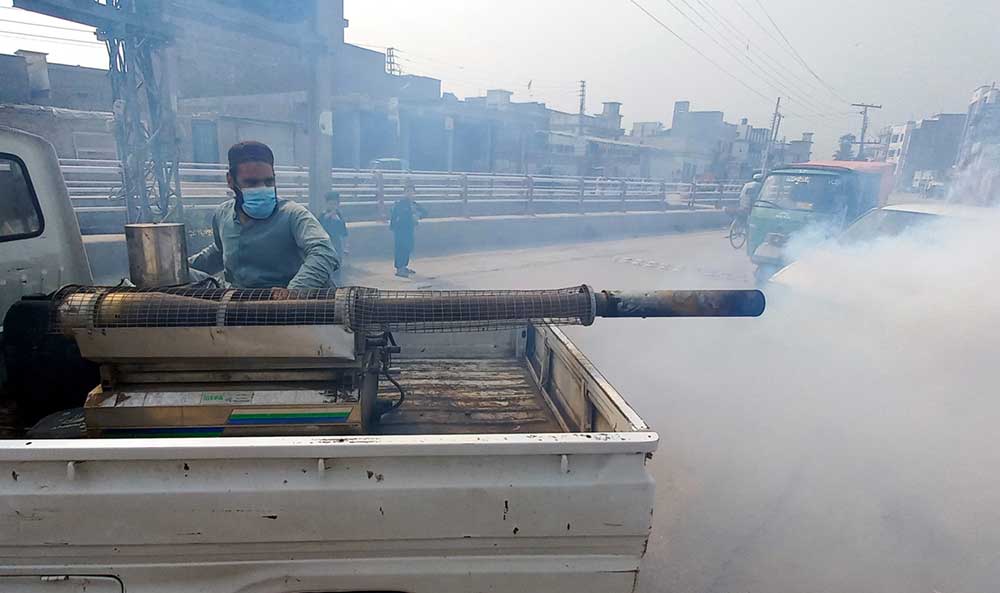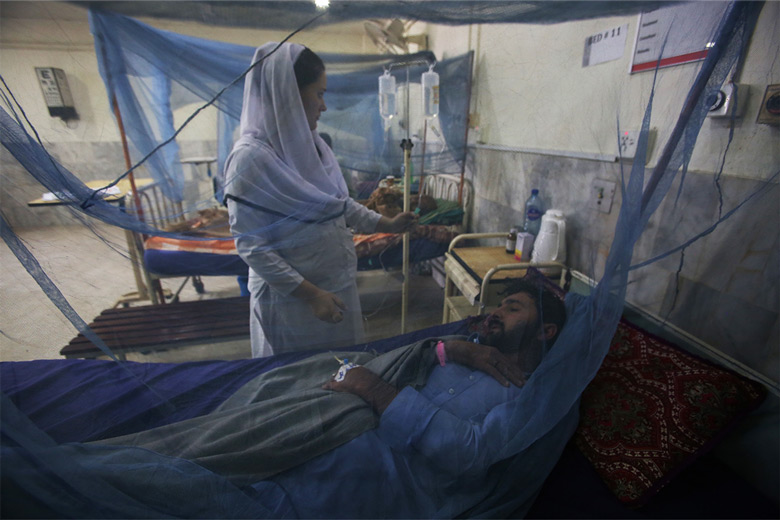Climate change causes malaria cases to triple in northwest Pakistan
In the wake of 2022’s floods, provincial health leaders say they need a new “climate-change specific” plan.
- 30 May 2024
- 5 min read
- by Adeel Saeed

Limp on his stretcher, 32-year-old Muhammad Jan was bundled by relatives into a private ambulance and rushed to Peshawar, the nearest metropolis. Doctors had referred him to a tertiary hospital in the city: he needed urgent treatment for a severe bout of malaria.
"The patient, at arrival on May 9, 2024, was running high fever with rigors, chills and abdominal pains, symptoms clearly indicating malaria infection with life-threatening complications," relates Dr Anthony Alamzeb Feroz, Coordinator of Public Health, Peshawar District.
KP’s malaria burden more than tripled in one year, a jump from 150,000 cases in 2022 to 500,000 in 2023.
Blood tests confirmed Jan's illness as caused by the parasite Plasmodium vivax, the malarial pathogen that accounts for 84% of all confirmed cases in Pakistan. Doctors started Jan on a course of injections combining antimalarial drugs Artesunate, Gen-M and Primaquine.
Recently, Dr Feroz has seen an uptick in the number of patients, especially from impoverished backgrounds, being brought to his ward in a similar condition. Just days before Jan's arrival, he told VaccinesWork, a very sick teenaged boy named Muhammad Riaz had been rushed to the hospital from Kurram district, on the Afghan border.
The physician is not alone in attributing the spike in malaria cases to climate change.
After the floods
"Climate-induced disasters, in the shape of devastating floods and excessive rains, have increased the burden of malaria manifold, registering an alarming spike in Khyber Pakhtunkhwa (KP) province in the preceding year of 2023," says Dr Irshad Roghani, Director Public Health Khyber Pakhtunkhwa.
Data compiled by the Public Health Department puts that in startlingly concrete terms: KP's malaria burden more than tripled in one year, a jump from 150,000 cases in 2022 to 500,000 in 2023, Dr Roghani disclosed.

Credit: Adeel Saeed
The 500,000 officially registered cases of malaria in 2023 are well short of the number of suspected malaria cases in the same year. KP's District Health Information System report for 2023 lists more than 1.1 million suspected malaria cases across the year, putting "suspected malaria" squarely in the province's top ten priority diseases.
2024's "wettest April" spooks health officials
"The Health Department is apprehensive and anticipating more spikes in cases of malaria and dengue in coming months of June and July 2024, because of the 'wettest April' recorded by the country in more than 60 years after 1961," shares Dr Amir Naeem, Chairman of the Medicine Department at Khyber Teaching Hospital, (KTH) Peshawar.
Have you read?
That's borne out by the monthly climate report issued by Pakistan's Meteorological Department in early May. "In April 2024, rainfall in the country was recorded 59.3 mm (2.3 inches) excessively above the normal average of 22.5 (0.9 inches), about 150 percent more than the usual for the month," the report reads.
"Excessive rains and cold weather provide [a] very favourable environment for mosquitoes to grow and spread in the country," observes Salauddin Marwat, an entomologist working in KP's Vector Control Programme.
Accumulation of standing water -- due to rains and floods – are the main source of increases in mosquito populations, resulting in an increase in vector-borne diseases, he adds.
Worst outbreak in five decades calls for a strategy revision
The connection between climate change and vector-borne illness is, at this point, hard to deny. The World Malaria Report of 2023, published by the World Health Organization (WHO), noted that "catastrophic flooding in Pakistan in 2022 led to a fivefold increase in malaria cases in the country, with about 2.6 million cases in 2022 compared to 500 000 in 2021."
"In 2022 and 2023, extreme monsoon rainfall affected many parts of Pakistan, with evidence suggesting that the severity of the monsoon season was heightened by climate change," the report reads.
Dr Muhammad Mukhtair, who leads Pakistan's Directorate of Malaria Control (DMC) tells VaccinesWork, "The country's 2022–2023 malaria outbreak has been classified as the heaviest in the last five decades."
"Excessive rains and cold weather provide [a] very favourable environment for mosquitoes to grow and spread in the country."
– Salauddin Marwat, entomologist
"After the impact of 2022 floods on health sector and vector-borne diseases, Pakistan has to revise its National Strategic Plan for Malaria Elimination 2021–35, making it climate-change specific," he continues.
Compared to 376,203 cases in 2021, health facilities reported 1.7 million cases in 2022 – a figure that does not include cases diagnosed and treated by numerous relief organisations during flood relief operations, according to Dr Mukhtair.
At a presentation on climate change and vector-borne disease presented at COP28 in Dubai, Dr Mukhtair told delegates: "The negative health impacts of climate change are particularly acute in Pakistan – such as rising temperatures, heatwaves, natural disasters, and displacement – and pose a significant risk to public health."
Currently, just 1.7% of the population of Pakistan live in areas classified as having no risk of malaria transmission, while 28.9% of the population live in areas at high risk for malaria, and 69.4% at low and medium risk, he cautions.
Not just health workers: scarcity of entomologists hampers prevention
"The province is faced with a shortage of entomologists for keeping a vigil over mosquito population," says Marwat. There are presently 41 entomologists in the province, and for effective preventive measures, the number needs to be enhanced to around 100, he suggests.
To prevent the spread of vector-borne diseases with a focus on dengue and malaria, Khyber Pakhtunkhwa's government published a plan of action in April.
The plan directs the concerned governmental departments to strictly follow standard operating procedures, including undertaking the mechanical destruction of outdoor breeding sites, conducting larva sweeping, arranging awareness walks in localities, incorporating dengue and other public health material in educational curricula, repairing damaged water channels to avoid stagnation, conducting anti-mosquito fogging operations, distributing bed-nets amongst people and educating vulnerable communities about use of mosquito repellents.

Credit: Adeel Saeed
Apart from active participation in the Dengue Action Plan, the Public Health Department has distributed more than 2 million mosquito nets as a protective measure, says Dr Irshad Roghani. Around 1,240 beds across various hospitals in the province have been allocated for dengue and malaria patients, to alleviate pressure on tertiary care hospitals.
The Health Department aims to make Khyber Pakhtunkhwa malaria-free by 2035. In the current year, an amount of 448 million rupees (US$ 1.6 million) has been reserved for malaria control, says Roghani.









